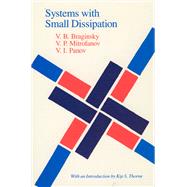
| Foreword | |
| Preface to the English Edition | |
| Preface to the Russian Edition | |
| Introduction | |
| Classical oscillators with small dissipation | |
| Quantum mechanical features of macroscopic oscillators | |
| Mechanical Oscillators with Small Dissipation | |
| Fundamental dissipative processes in solids | |
| Thermoelastic dissipation | |
| Dissipation due to phonon-phonon interactions | |
| Dissipation due to phonon-electron interactions in metals | |
| Dissipation due to lattice defects and the internal structures of solid bodies | |
| Energy losses arising from the design of a mechanical resonator | |
| Losses due to gas friction | |
| Surface losses | |
| Losses due to coupling of different kinds of vibrations | |
| Losses in a resonator's suspension | |
| High-Q resonators made from sapphire monocrystals | |
| Electromagnetic Resonators with Small Dissipation | |
| Superconducting cavity electromagnetic resonators | |
| Surface resistance and residual resistance of superconductors | |
| Quality factors of superconducting resonators | |
| Frequency stability of superconducting resonators | |
| Methods of constructing superconducting resonators | |
| Properties of superconducting resonators with dielectric interiors | |
| High-quality dielectric ring resonators | |
| Radiative losses due to curvature of the waveguide | |
| Radiative losses due to spatial variations of the dielectric constant inside the resonator | |
| Radiative losses due to roughness or to smooth inhomogeneities of the resonator's geometry | |
| High-quality Electromagnetic Resonators in Physical Experiments | |
| Electromagnetic self-excited oscillators stabilized by high-quality superconducting resonators | |
| Applications of superconducting resonators in radiophysical measurements | |
| Measurements of very small mechanical vibrations | |
| Measurements of small electromagnetic losses in solids | |
| Measurements of the surface impedances of superconductors | |
| Other applications of superconducting resonators | |
| Mechanical Oscillators in Physical Experiments | |
| Mechanical gravitational antennae | |
| Applications of high-quality mechanical resonators to frequency stabilization | |
| Epilogue to the English Edition | |
| Bibliography | |
| Index | |
| Table of Contents provided by Publisher. All Rights Reserved. |
The New copy of this book will include any supplemental materials advertised. Please check the title of the book to determine if it should include any access cards, study guides, lab manuals, CDs, etc.
The Used, Rental and eBook copies of this book are not guaranteed to include any supplemental materials. Typically, only the book itself is included. This is true even if the title states it includes any access cards, study guides, lab manuals, CDs, etc.